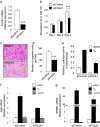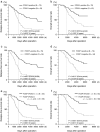Association of double-positive FOXA1 and FOXP1 immunoreactivities with favorable prognosis of tamoxifen-treated breast cancer patients
- PMID: 22476979
- PMCID: PMC10358124
- DOI: 10.1007/s12672-012-0111-0
Association of double-positive FOXA1 and FOXP1 immunoreactivities with favorable prognosis of tamoxifen-treated breast cancer patients
Abstract
Breast cancer is primarily a hormone-dependent tumor that can be regulated by the status of the steroid hormones estrogen and progesterone. Forkhead box A1 (FOXA1) is a member of the forkhead box transcription factor family and functions as a pioneer factor of the estrogen receptor (ER) in breast cancer. In the present study, we demonstrate that FOXA1 mRNA was upregulated by estrogen and that estrogen receptor-α (ERα) recruitment to ER-binding sites in the vicinity of the FOXA1 gene was increased by estrogen in ERα-positive MCF-7 breast cancer cells. The estrogen-induced FOXA1 upregulation was repressed by 4-hydroxytamoxifen treatment. We also demonstrated that the proliferation and the migration of MCF-7 cells were decreased by FOXA1-specific small interfering RNA (siRNA; siFOXA1). Furthermore, siFOXA1 decreased the estrogen response element-driven transcription and the estrogen-dependent upregulation of ERα target genes in MCF-7 cells. Next, the immunohistochemical analyses of FOXA1 were performed using two groups of breast cancer specimens. The nuclear immunoreactivity of FOXA1 was detected in 80 (74%) of 108 human invasive breast cancers and was negatively correlated with tumor grade and positively correlated with hormone receptor status, including ERα and progesterone receptor, pathological tumor size, and immunoreactivity of FOXP1, another FOX family transcription factor. FOXA1 immunoreactivity was significantly elevated in the relapse-free breast cancer patients treated with tamoxifen. Notably, the double-positive immunoreactivities of FOXA1 and FOXP1 were significantly associated with a favorable prognosis for the relapse-free and overall survival of patients with tamoxifen-treated breast cancer, with lower P values compared with FOXA1 or FOXP1 immunoreactivity alone. These results suggest that FOXA1 plays an important role in the proliferation and migration of breast cancer cells by modulating estrogen signaling and that the double-positive immunoreactivities of FOXA1 and FOXP1 are associated with a favorable prognosis of tamoxifen-treated breast cancer.
Conflict of interest statement
The authors declare that they have no conflict of interest.
Figures




Similar articles
-
FOXP1, an estrogen-inducible transcription factor, modulates cell proliferation in breast cancer cells and 5-year recurrence-free survival of patients with tamoxifen-treated breast cancer.Horm Cancer. 2011 Oct;2(5):286-97. doi: 10.1007/s12672-011-0082-6. Horm Cancer. 2011. PMID: 21901488 Free PMC article.
-
FOXP1 and estrogen signaling in breast cancer.Vitam Horm. 2013;93:203-12. doi: 10.1016/B978-0-12-416673-8.00006-X. Vitam Horm. 2013. PMID: 23810008 Review.
-
Loss of Rho GDIα and resistance to tamoxifen via effects on estrogen receptor α.J Natl Cancer Inst. 2011 Apr 6;103(7):538-52. doi: 10.1093/jnci/djr058. Epub 2011 Mar 29. J Natl Cancer Inst. 2011. PMID: 21447808 Free PMC article.
-
Comparative Cistromics Reveals Genomic Cross-talk between FOXA1 and ERα in Tamoxifen-Associated Endometrial Carcinomas.Cancer Res. 2016 Jul 1;76(13):3773-84. doi: 10.1158/0008-5472.CAN-14-1813. Epub 2016 May 6. Cancer Res. 2016. PMID: 27197147
-
FOXA1 as a therapeutic target for breast cancer.Expert Opin Ther Targets. 2007 Apr;11(4):507-14. doi: 10.1517/14728222.11.4.507. Expert Opin Ther Targets. 2007. PMID: 17373880 Review.
Cited by
-
Cytoplasmic FOXP1 expression is correlated with ER and calpain II expression and predicts a poor outcome in breast cancer.Diagn Pathol. 2018 May 30;13(1):36. doi: 10.1186/s13000-018-0715-y. Diagn Pathol. 2018. PMID: 29848352 Free PMC article.
-
Efficacy, Safety, and Prognosis of Sequential Therapy with Tamoxifen and Letrozole versus Letrozole Monotherapy for Breast Carcinoma.Comput Math Methods Med. 2022 Apr 14;2022:1979254. doi: 10.1155/2022/1979254. eCollection 2022. Comput Math Methods Med. 2022. Retraction in: Comput Math Methods Med. 2023 Sep 27;2023:9804628. doi: 10.1155/2023/9804628. PMID: 35464999 Free PMC article. Retracted.
-
FOXA1 in Breast Cancer: A Luminal Marker with Promising Prognostic and Predictive Impact.Cancers (Basel). 2022 Sep 27;14(19):4699. doi: 10.3390/cancers14194699. Cancers (Basel). 2022. PMID: 36230619 Free PMC article.
-
Genome instability in blood cells of a BRCA1+ breast cancer family.BMC Cancer. 2014 May 19;14:342. doi: 10.1186/1471-2407-14-342. BMC Cancer. 2014. PMID: 24884718 Free PMC article.
-
Clinicopathological significance of forkhead box protein A1 in breast cancer: A meta-analysis.Exp Ther Med. 2016 Jun;11(6):2525-2530. doi: 10.3892/etm.2016.3229. Epub 2016 Apr 6. Exp Ther Med. 2016. PMID: 27284343 Free PMC article.
References
Publication types
MeSH terms
Substances
LinkOut - more resources
Full Text Sources
Medical
Research Materials

